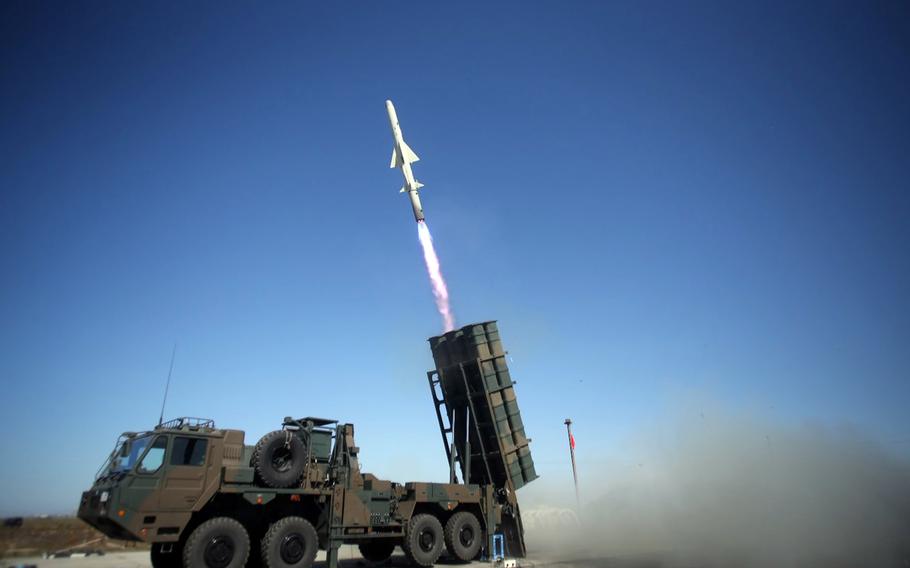Asia-Pacific
Long-range missiles for Okinawa should come with local buy-in, experts say
Stars and Stripes December 15, 2022

Members of the Japan Ground Self-Defense Force fire a Type 12 surface-to-ship missile in this undated photo. (Japan Ground Self-Defense Force)
CAMP FOSTER, Okinawa — A reported plan by Japan to base long-range missiles in Okinawa prefecture without first gaining local acceptance could erode confidence in the U.S.-Japan alliance, an American professor in Tokyo said recently.
The Japanese Ministry of Defense by 2026 plans to base Type 12 surface-to-ship missiles at three Japan Self-Defense Force bases in the Ryukyu Island chain: Vice Camp Katsuren adjacent to the Navy’s White Beach Naval Facility on Okinawa; Camp Miyako on Miyako, an island 175 miles southwest of Okinawa; and Ishigaki, an island about 150 miles east of Taiwan, according to an Okinawa Times report Sunday that cited unnamed officials.
"Not consulting locals raises the issue of legitimacy," Jeff Kingston, professor of Asian studies at Temple University’s Tokyo campus, told Stars and Stripes in an email Wednesday. "Yet again the nation is outsourcing its defense to Okinawa and Okinawans remain marginalized from the decision-making."
An upgraded version of the high-speed, truck-mounted Type 12 is under development and would extend its range from 62 to 620 miles. That puts them in reach of potential targets around the Senkaku Islands and parts of China and North Korea.
Prime Minister Fumio Kishida's Liberal Democratic Party and their conservative coalition partner, Komeito, agreed Monday to acquire counterstrike capability, the power to strike an adversaries’ missile sites, for example, in the event of attack on Japan, according to an Okinawa Times report the following day. This language has reportedly been written into a national security strategy that Kishida's cabinet may approve as early as Friday.
The Type-12s would also be deployed to Kyushu, the southernmost of Japan’s four main islands, the Okinawa Times said Sunday.
The Ministry of Defense in an email Tuesday to Stars and Stripes declined to confirm the Okinawa Times report. The ministry is considering "many things" regarding potential areas where the missiles might be placed, according to the email.
"We don’t exclude any option and are considering realistically if we have the resources to protect the lives of Japanese citizens," the ministry said.
Okinawa Gov. Denny Tamaki, addressing the prefectural assembly Monday, said that if Tokyo wants "deterrence power" it must first explain it to Okinawa's citizenry. He did not otherwise mention the missile-deployment report.
"If the reduction of U.S. bases is conducted at the same time, leading to the reduction of Okinawa’s base burden, I would admit that line of thinking," he said.
News of the potential missile deployment left experts divided.
"The missiles must be deployed at Okinawa," Toshiyuki Shikata, a former lieutenant general in the Japan Ground Self-Defense Force, told Stars and Stripes by phone Monday. "Shooting long-range missiles from Tokyo or Kyushu is too far to reach enemy bases. I know that the Okinawans won’t like it, but it is necessary."
The central government needs to explain to the people of Okinawa why the missiles must be placed where they can reach potential targets, Shikata said.
Junjiro Shida, an associate professor of international politics at Meio University on Okinawa, agreed.
"The situation around Okinawa is very tense," he said by phone Monday. "China needs to pass through Okinawa to expand its maritime forces. It is important to strengthen Okinawa, independently of the Taiwan issue."
Takashi Kishimoto, a deputy secretary-general of the Okinawa Peace Activity Center, an anti-base group, said he was troubled by the reports.
"This will raise tensions in the region,” he told Stars and Stripes by phone Monday, “and if the missiles are deployed in Okinawa, we might be attacked.”